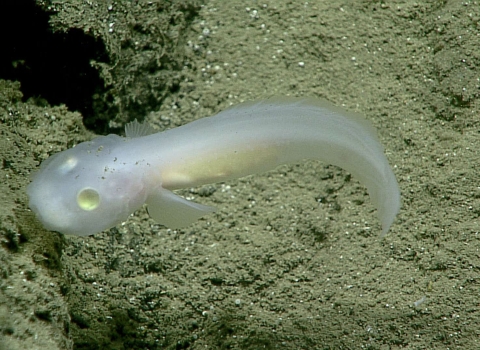A draft recovery plan is now available for the trispot darter, listed as threatened under the Endangered Species Act in 2019. This plan includes specific criteria for determining when the trispot darter should be considered for delisting, removing it from the Federal List of Endangered and Threatened Wildlife. It also lists site-specific actions that will be necessary to meet those criteria and estimates the time and costs required for implementing actions necessary to achieve recovery.
The trispot darter is a freshwater fish found in the Coosa River System in the Ridge and Valley eco-region of Alabama, Georgia, and Tennessee. This fish has a historical range from the middle to upper Coosa River Basin with collections in the mainstem Coosa, Oostanaula, Conasauga, and Coosawattee Rivers, and their tributaries.
Currently, the trispot darter is known to occur in four management units in the Little Canoe Creek and tributaries (Coosa River), Ballplay Creek tributaries (Coosa River), Conasauga River and tributaries, and Coosawattee River and one tributary.
The trispot darter is a migratory species that utilizes distinct breeding and non-breeding habitats. From approximately April to October, the species inhabits its non-breeding habitat, which consists of small to medium river margins and lower reaches of tributaries with slower velocities. Migration into spawning areas begins approximately late November or early December with fish moving from the main channels into tributaries and eventually reaching adjacent seepage areas where they will congregate and remain for the duration of spawning.
According to the draft recovery plan and the best available science, the trispot darter may be considered for delisting when these criteria are met: (1) At least six populations exhibit a stable or increasing trend, evidenced by natural recruitment, recruitment rates exceeding mortality rates, and multiple age classes; (2) Spatial distribution of the six populations includes at least one population in four of the five historical river basins; and, (3) Threats have been addressed and/or managed to the extent that the species will remain viable based on scientifically defensible evaluation methods, for the foreseeable future.
The Service recently revised the recovery planning process for all listed species, nationwide. With this revised process, actual on‐the‐ground activities for implementing the actions in the recovery plan are described in a separate document known as the Recovery Implementation Strategy (RIS). The RIS is intended to be an adaptable, nimble operational plan for stepping down recovery plan actions into manageable, step‐by‐step activities. This adaptive mechanism is intended to allow the plan to focus on a longer, more strategic timeframe while providing greater flexibility in how we implement the recovery plan.
We seek comments on the draft plan from Federal, Tribal, State, and local governments. We are particularly interested in additional information regarding the current threats to the species, ongoing beneficial management efforts, and the costs associated with implementing the recommended recovery actions. Comments may be submitting in writing to Alabama Field Supervisor William J. Pearson at bill_pearson@fws.gov, or mail to the Alabama Ecological Services Field Office at the address below.
To ensure consideration, we must receive written comments on or before 30 days after the comment period opens. However, we will accept information about any species at any time.
Copies of the draft recovery plan are available on the internet at:
https://ecos.fws.gov/ecp/species/8219 or https://www.fws.gov/program/recovery/recovery-plans
Hard copies are available by request. Please submit your request to U.S. Fish and Wildlife Service, Alabama Ecological Services Field Office, 1208 Main Street, Daphne, Alabama 36526. Telephone: 251/441-5181.
The mission of the U.S. Fish and Wildlife Service is working with others to conserve, protect, and enhance fish, wildlife, plants, and their habitats for the continuing benefit of the American people. For more information on our work and the people who make it happen, visit www.fws.gov/southeast. Connect with us on Facebook at www.facebook.com/usfwssoutheast, follow our tweets at www.twitter.com/usfwssoutheast, watch our YouTube Channel at http://www.youtube.com/usfws, and download photos from our Flickr page at http://www.flickr.com/photos/usfwssoutheast.



